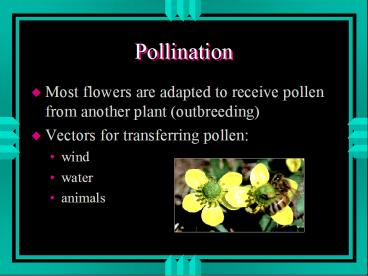Pollination - PowerPoint PPT Presentation
1 / 12
Title:
Pollination
Description:
Building & Sustaining Business Partnerships. Agenda. Business ... Building Business Relationships. Building Business Relationships. Relationship Building Tips ... – PowerPoint PPT presentation
Number of Views:212
Avg rating:3.0/5.0
Title: Pollination
1
Pollination
- Most flowers are adapted to receive pollen from
another plant (outbreeding) - Vectors for transferring pollen
- wind
- water
- animals
2
SEM photos of pollen
Ragweed
Dandelion
3
Attraction
- To first attract an animal pollinator, plants
have evolved two general types of cues - Visual
- Olfactory
4
Attraction
- To first attract an animal pollinator, plants
have evolved two general types of cues - Visual
- Olfactory
- For repeat visits, a reward is usually necessay
- eg. nectar, pollen, oils, place to mate or rest
5
Visual cues - examples
- Bullseye
- Color contrast that creates a target
6
Pollinator vision
- Pollinators often see different wavelengths than
we do
Gaillardia - butterflies and bees
7
Pollinator vision
- Pollinators often see different wavelengths than
we do - Bees miss the red wavelengths but see UV
Gaillardia - butterflies and bees
No red UV
BW photo
No red
8
Rewards -Nectar guides
- Violets - note the bullseye and the dark lines
(nectar guides) - Bullseye shows opening to spur and nectar
9
Nectar spurs
- Limits the type of pollinator that can gain the
reward - Keeps pollen transfer within species
- Orientation is
- typical for
- hummingbird
- flowers
10
Combination
- Bird must line up red/yellow bullseye with dark
red one - As it moves in, it brushes stigmas first, then
anthers with its head
11
Mechanical help
12
(No Transcript)































